- Home
- William Morris
The House of the Wolfings
The House of the Wolfings Read online
Transcribed from the 1904 Longmans, Green, and Co. edition by DavidPrice, email [email protected]
THE HOUSE OF THE WOLFINGSA TALE OF THE HOUSE OF THE WOLFINGS AND ALL THE KINDREDS OF THE MARKWRITTEN IN PROSE AND IN VERSEby William Morris
Whiles in the early Winter eve We pass amid the gathering night Some homestead that we had to leave Years past; and see its candles bright Shine in the room beside the door Where we were merry years agone But now must never enter more, As still the dark road drives us on. E'en so the world of men may turn At even of some hurried day And see the ancient glimmer burn Across the waste that hath no way; Then with that faint light in its eyes A while I bid it linger near And nurse in wavering memories The bitter-sweet of days that were.
CHAPTER I--THE DWELLINGS OF MID-MARK
The tale tells that in times long past there was a dwelling of men besidea great wood. Before it lay a plain, not very great, but which was, asit were, an isle in the sea of woodland, since even when you stood on theflat ground, you could see trees everywhere in the offing, though as forhills, you could scarce say that there were any; only swellings-up of theearth here and there, like the upheavings of the water that one sees atwhiles going on amidst the eddies of a swift but deep stream.
On either side, to right and left the tree-girdle reached out toward theblue distance, thick close and unsundered, save where it and the plainwhich it begirdled was cleft amidmost by a river about as wide as theThames at Sheene when the flood-tide is at its highest, but so swift andfull of eddies, that it gave token of mountains not so far distant,though they were hidden. On each side moreover of the stream of thisriver was a wide space of stones, great and little, and in most placesabove this stony waste were banks of a few feet high, showing where theyearly winter flood was most commonly stayed.
You must know that this great clearing in the woodland was not a matterof haphazard; though the river had driven a road whereby men might fareon each side of its hurrying stream. It was men who had made that Islein the woodland.
For many generations the folk that now dwelt there had learned the craftof iron-founding, so that they had no lack of wares of iron and steel,whether they were tools of handicraft or weapons for hunting and for war.It was the men of the Folk, who coming adown by the river-side had madethat clearing. The tale tells not whence they came, but belike from thedales of the distant mountains, and from dales and mountains and plainsfurther aloof and yet further.
Anyhow they came adown the river; on its waters on rafts, by its shoresin wains or bestriding their horses or their kine, or afoot, till theyhad a mind to abide; and there as it fell they stayed their travel, andspread from each side of the river, and fought with the wood and its wildthings, that they might make to themselves a dwelling-place on the faceof the earth.
So they cut down the trees, and burned their stumps that the grass mightgrow sweet for their kine and sheep and horses; and they diked the riverwhere need was all through the plain, and far up into the wild-wood tobridle the winter floods: and they made them boats to ferry them over,and to float down stream and track up-stream: they fished the river'seddies also with net and with line; and drew drift from out of it of far-travelled wood and other matters; and the gravel of its shallows theywashed for gold; and it became their friend, and they loved it, and gaveit a name, and called it the Dusky, and the Glassy, and theMirkwood-water; for the names of it changed with the generations of man.
There then in the clearing of the wood that for many years grew greateryearly they drave their beasts to pasture in the new-made meadows, whereyear by year the grass grew sweeter as the sun shone on it and thestanding waters went from it; and now in the year whereof the taletelleth it was a fair and smiling plain, and no folk might have a bettermeadow.
But long before that had they learned the craft of tillage and taken heedto the acres and begun to grow wheat and rye thereon round about theirroofs; the spade came into their hands, and they bethought them of theplough-share, and the tillage spread and grew, and there was no lack ofbread.
In such wise that Folk had made an island amidst of the Mirkwood, andestablished a home there, and upheld it with manifold toil too long totell of. And from the beginning this clearing in the wood they calledthe Mid-mark: for you shall know that men might journey up and down theMirkwood-water, and half a day's ride up or down they would come onanother clearing or island in the woods, and these were the Upper-markand the Nether-mark: and all these three were inhabited by men of onefolk and one kindred, which was called the Mark-men, though of manybranches was that stem of folk, who bore divers signs in battle and atthe council whereby they might be known.
Now in the Mid-mark itself were many Houses of men; for by that word hadthey called for generations those who dwelt together under one token ofkinship. The river ran from South to North, and both on the East sideand on the West were there Houses of the Folk, and their habitations wereshouldered up nigh unto the wood, so that ever betwixt them and the riverwas there a space of tillage and pasture.
Tells the tale of one such House, whose habitations were on the west sideof the water, on a gentle slope of land, so that no flood higher thancommon might reach them. It was straight down to the river mostly thatthe land fell off, and on its downward-reaching slopes was the tillage,"the Acres," as the men of that time always called tilled land; andbeyond that was the meadow going fair and smooth, though with here andthere a rising in it, down to the lips of the stony waste of the winterriver.
Now the name of this House was the Wolfings, and they bore a Wolf ontheir banners, and their warriors were marked on the breast with theimage of the Wolf, that they might be known for what they were if theyfell in battle, and were stripped.
The house, that is to say the Roof, of the Wolfings of the Mid-mark stoodon the topmost of the slope aforesaid with its back to the wild-wood andits face to the acres and the water. But you must know that in thosedays the men of one branch of kindred dwelt under one roof together, andhad therein their place and dignity; nor were there many degrees amongstthem as hath befallen afterwards, but all they of one blood were brethrenand of equal dignity. Howbeit they had servants or thralls, men taken inbattle, men of alien blood, though true it is that from time to time weresome of such men taken into the House, and hailed as brethren of theblood.
Also (to make an end at once of these matters of kinship and affinity)the men of one House might not wed the women of their own House: to theWolfing men all Wolfing women were as sisters: they must needs wed withthe Hartings or the Elkings or the Bearings, or other such Houses of theMark as were not so close akin to the blood of the Wolf; and this was alaw that none dreamed of breaking. Thus then dwelt this Folk and suchwas their Custom.
As to the Roof of the Wolfings, it was a great hall and goodly, after thefashion of their folk and their day; not built of stone and lime, butframed of the goodliest trees of the wild-wood squared with the adze, andbetwixt the framing filled with clay wattled with reeds. Long was thathouse, and at one end anigh the gable was the Man's-door, not so highthat a man might stand on the threshold and his helmcrest clear thelintel; for such was the custom, that a tall man must bow himself as hecame into the hall; which custom maybe was a memory of the days ofonslaught when the foemen were mostly wont to beset the hall; whereas inthe days whereof the tale tells they drew out into the fields and foughtunfenced; unless at whiles when the odds were over great, and then theydrew their wains about them and were fenced by the wain-burg. At leastit was from no niggardry that the door was made thus low, as might beseen by the fair and manifold carving of knots and dragons that waswrought above the lintel of the door for some three foot's space. But alike door was there anigh the
other gable-end, whereby the women entered,and it was called the Woman's-door.
Near to the house on all sides except toward the wood were there manybowers and cots round about the penfolds and the byres: and these werebooths for the stowage of wares, and for crafts and smithying that wereunhandy to do in the house; and withal they were the dwelling-places ofthe thralls. And the lads and young men often abode there many days andwere cherished there of the thralls that loved them, since at whiles theyshunned the Great Roof that they might be the freer to come and go attheir pleasure, and deal as they would. Thus was there a clustering onthe slopes and bents betwixt the acres of the Wolfings and the wild-woodwherein dwelt the wolves.
As to the house within, two rows of pillars went down it endlong,fashioned of the mightiest trees that might be found, and each one fairlywrought with base and chapiter, and wreaths and knots, and fighting menand dragons; so that it was like a church of later days that has a naveand aisles: windows there were above the aisles, and a passage underneaththe said windows in their roofs. In the aisles were the sleeping-placesof the Folk, and down the nave under the crown of the roof were threehearths for the fires, and above each hearth a luffer or smoke-bearer todraw the smoke up when the fires were lighted. Forsooth on a brightwinter afternoon it was strange to see the three columns of smoke goingwavering up to the dimness of the mighty roof, and one maybe smittenathwart by the sunbeams. As for the timber of the roof itself and itsframing, so exceeding great and high it was, that the tale tells how thatnone might see the fashion of it from the hall-floor unless he were toraise aloft a blazing faggot on a long pole: since no lack of timber wasthere among the men of the Mark.
At the end of the hall anigh the Man's-door was the dais, and a tablethereon set thwartwise of the hall; and in front of the dais was thenoblest and greatest of the hearths; (but of the others one was in thevery midmost, and another in the Woman's-Chamber) and round about thedais, along the gable-wall, and hung from pillar to pillar were wovencloths pictured with images of ancient tales and the deeds of theWolfings, and the deeds of the Gods from whence they came. And this wasthe fairest place of all the house and the best-beloved of the Folk, andespecially of the older and the mightier men: and there were tales told,and songs sung, especially if they were new: and thereto also weremessengers brought if any tidings were abroad: there also would theelders talk together about matters concerning the House or the Mid-markor the whole Folk of the Markmen.
Yet you must not think that their solemn councils were held there, thefolk-motes whereat it must be determined what to do and what to forbeardoing; for according as such councils, (which they called Things) were ofthe House or of the Mid-mark or of the whole Folk, were they held each atthe due Thing-steads in the Wood aloof from either acre or meadow, (aswas the custom of our forefathers for long after) and at such Thingswould all the men of the House or the Mid-mark or the Folk be present manby man. And in each of these steads was there a Doomring wherein Doomwas given by the neighbours chosen, (whom now we call the Jury) inmatters between man and man; and no such doom of neighbours was given,and no such voice of the Folk proclaimed in any house or under any roof,nor even as aforesaid on the tilled acres or the depastured meadows. Thiswas the custom of our forefathers, in memory, belike, of the days when asyet there was neither house nor tillage, nor flocks and herds, but theEarth's face only and what freely grew thereon.
But over the dais there hung by chains and pulleys fastened to a tie-beamof the roof high aloft a wondrous lamp fashioned of glass; yet of no suchglass as the folk made then and there, but of a fair and clear green likean emerald, and all done with figures and knots in gold, and strangebeasts, and a warrior slaying a dragon, and the sun rising on the earth:nor did any tale tell whence this lamp came, but it was held as anancient and holy thing by all the Markmen, and the kindred of the Wolfhad it in charge to keep a light burning in it night and day for ever;and they appointed a maiden of their own kindred to that office; whichdamsel must needs be unwedded, since no wedded woman dwelling under thatroof could be a Wolfing woman, but would needs be of the houses whereinthe Wolfings wedded.
This lamp which burned ever was called the Hall-Sun, and the woman whohad charge of it, and who was the fairest that might be found was calledafter it the Hall-Sun also.
At the other end of the hall was the Woman's-Chamber, and therein werethe looms and other gear for the carding and spinning of wool and theweaving of cloth.
Such was the Roof under which dwelt the kindred of the Wolfings; and theother kindreds of the Mid-mark had roofs like to it; and of these thechiefest were the Elkings, the Vallings, the Alftings, the Beamings, theGaltings, and the Bearings; who bore on their banners the Elk, theFalcon, the Swan, the Tree, the Boar, and the Bear. But other lesser andnewer kindreds there were than these: as for the Hartings above named,they were a kindred of the Upper-mark.

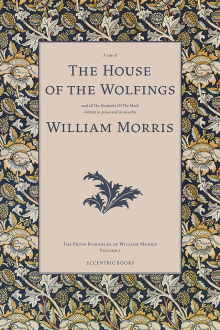 The House of the Wolfings
The House of the Wolfings The Wood Beyond the World
The Wood Beyond the World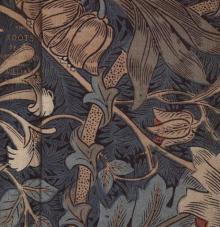 The Roots of the Mountains
The Roots of the Mountains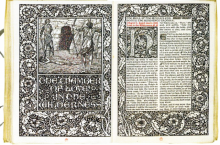 The Well at the World's End: A Tale
The Well at the World's End: A Tale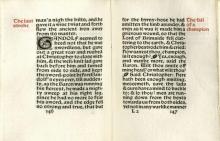 Child Christopher and Goldilind the Fair
Child Christopher and Goldilind the Fair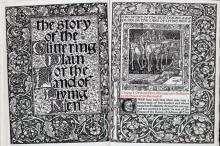 The Story of the Glittering Plain
The Story of the Glittering Plain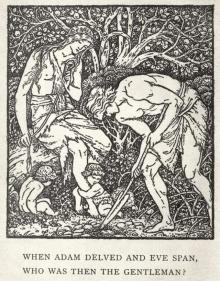 A Dream of John Ball; and, A King's Lesson
A Dream of John Ball; and, A King's Lesson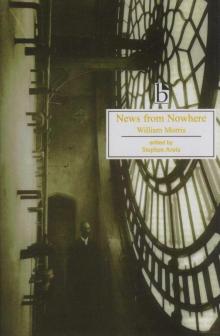 News From Nowhere, Or, an Epoch of Rest, Being Some Chapters From a Utopian Romance
News From Nowhere, Or, an Epoch of Rest, Being Some Chapters From a Utopian Romance